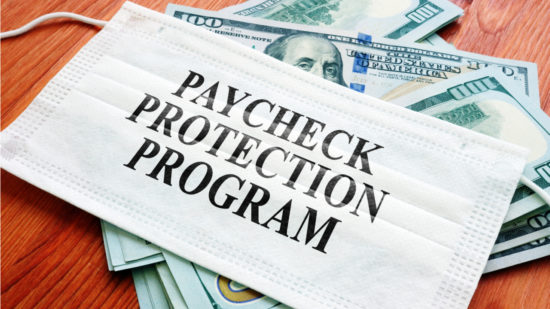Paycheck Protection Program Flexibility Act
On June 5, 2020, President Trump signed the Paycheck Protection Program Flexibility Act (Act) into law. The Act is intended to modify several provisions of the Paycheck Protection Program (PPP) enacted under the CARES Act. The major amendments are highlighted below:
Determining the Forgiveness Amount:
- Originally, the forgiveness amount of a PPP loan was determined by the eight-week period following the date the loan was originated and the Employer received the PPP proceeds. The Act extended the eight-week period to a 24-week period from the date the loan was originated and the PPP proceeds received, or by December 31, 2020. This provides employers up to 24 weeks to spend PPP proceeds and still be eligible for forgiveness.
Safe Harbor Expansion:
- A reduction in the forgivable amount of the PPP loan occurs if the borrower fails to maintain its full-time employees (FTE) after receiving the loan or reduces their salary/wage compensation. However, the PPP provides a certain safe harbor that allows a borrower to avoid a reduction in the forgivable amount if: (1) the borrower’s total FTE count and compensation in the pay period inclusive of February 15, 2020 was greater than the borrower’s total average FTE between February 15, 2020 and April 26, 2020; and (2) the borrower’s total FTE in count and compensation as of June 30, 2020 was greater or equal to the borrower’s total FTE count and compensation in the pay period inclusive of February 15, 2020.
- The Act allows this safe harbor to apply if: (1) the borrower’s total FTE count and compensation in the pay period inclusive of February 15, 2020 was greater than the borrower’s total average FTE between February 15, 2020 and April 26, 2020; and (2) the borrower’s total FTE count and compensation as of December 31, 2020 was greater than or equal to the borrower’s total FTE count and compensation in the pay period inclusive of February 15, 2020. In essence, borrowers have until December 31, 2020 to restore their FTE workforce and their compensation levels and still receive 100% loan forgiveness.
Reduction in 75% Payroll Cost Requirement to 60%:
- There was no statutory requirement in the CARES Act that a certain percentage of the PPP loan must be used for payroll costs and benefits to be forgivable. However, the U.S. Treasury Department issued regulations requiring that at least 75% of the loan proceeds be used on eligible payroll costs. The remaining 25% could be used to pay for rent, qualified mortgage interest, and utility costs.
- The Act allows a borrower to use at least 60% of the PPP loan for payroll costs. This allows borrowers to use up to 40% of the PPP loan for rent, qualified mortgage interest and utility costs. However, the percentage of use for payroll costs and benefits has now become a “cliff.” If at least 60% of the PPP loan is NOT used for payroll and benefits, then the PPP loan may not be forgiven.
FTE Reduction Factor Exception
- After the PPP was passed, the Treasury Department issued rules under its administrative authority to create exceptions for borrowers trying to restore their employee count and compensation levels. Examples include documenting that the borrower made a qualified offer of employment to a laid off employee and the offer was declined, if the employee was fired for cause, or if the employee voluntarily resigned.
- Under the Act, certain employees who cannot be restored will not be counted against the loan forgiveness if the borrower in good faith is able to document: (1) the inability to rehire individuals who were employees of the borrower on February 15, 2020; and (2) the inability to hire similarly qualified employees for unfilled positions on or before December 31, 2020. The borrower can also document an inability to return to the same level of business activity as the business was operating at before February 15, 2020, due to compliance with requirements or guidance issued by state and federal health and human service departments, the CDC, or OSHA during the period between March 1, 2020 to December 31, 2020 and that relates to certain COVID-19 issues like sanitation, shut downs, social distancing, or safety requirements.
- It is unclear whether the U.S. Treasury will keep its regulations regarding employees who were fired for cause, voluntarily resigned, or refused to return to work after being offered work.
Extension of PPP loan maturity period
- U.S. Treasury Department issued a regulatory rule providing that PPP loans would have only a two-year loan period/maturity date following the date the borrower applied for loan forgiveness, but some or all of the loan proceeds were not forgiven. Under the Act, a PPP borrower that has a balance after applying for loan forgiveness will have a minimum maturity of 5 years and a maximum maturity of 10 years from the date on which the borrower applies for loan forgiveness.
Extension of Loan Deferral Period
- Under PPP, lenders must allow for a deferral of loan payments and related interest for at least six months and not more than a year. The Act now provides Lenders will have to allow for deferral until the date that the amount of loan forgiveness is remitted by the borrower to the lender. If the borrower does not apply for forgiveness within 10 months after the close of the “loan forgiveness” covered period, payments of principal, interest, and fees on the loan must begin no earlier than that date.
Expansion Act Employment Tax Deferral Provision
- Under the PPP, employers can generally defer the deposit and payment of the employer’s share of Social Security taxes. The deferral applies to deposits and payments required between March 27, 2020 through December 31, 2020. However, if an employer had a PPP loan forgiven, then deposits and payments due after the date of forgiveness are no longer eligible for deferral.
- The Act now states that if an employer applies for and receives forgiveness on some or all of its PPP loan, the employer will still be eligible for this tax deferral program. An employer that defers its social security payments will be required to pay 50% of the deferred amount by December 31, 2021 and the remaining amount by December 31, 2022 .
There is still a major issue with the taxability of the PPP loans. Although the PPP states that the forgivable loan amount is not taxable, the IRS has taken the position that employers cannot deduct expenses like payroll and rent that are paid with PPP funds. The IRS claims not allowing the deductions will prevent employers from receiving a “double tax benefit.” Members of Congress have already spoken out that it was their intent to have the forgiven loan amount be tax free while still allowing the deductions. Without a legislative fix to this issue, employers should plan for the additional tax ramifications from the PPP loan.
If you have any questions or need information, please contact either Lynn Schonberg or Nick Nykulak.

